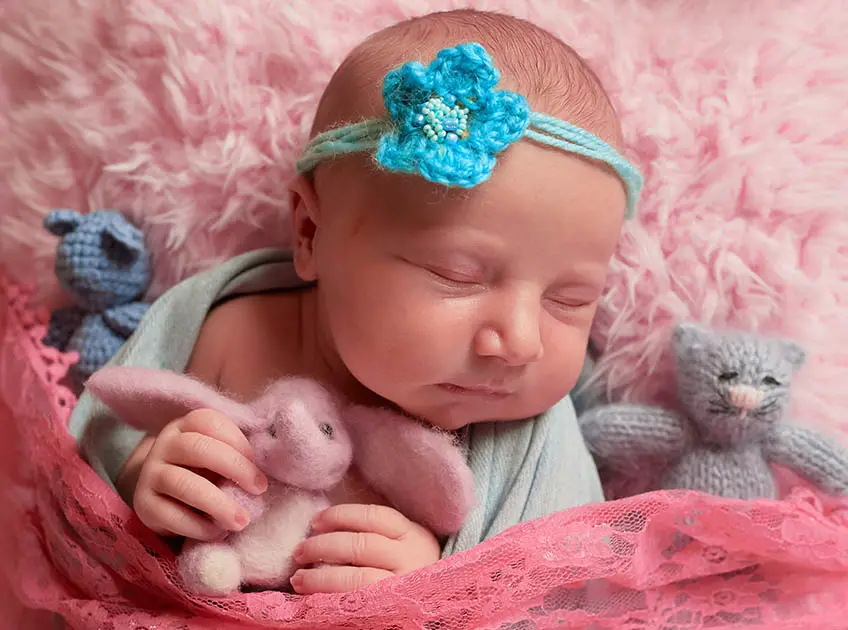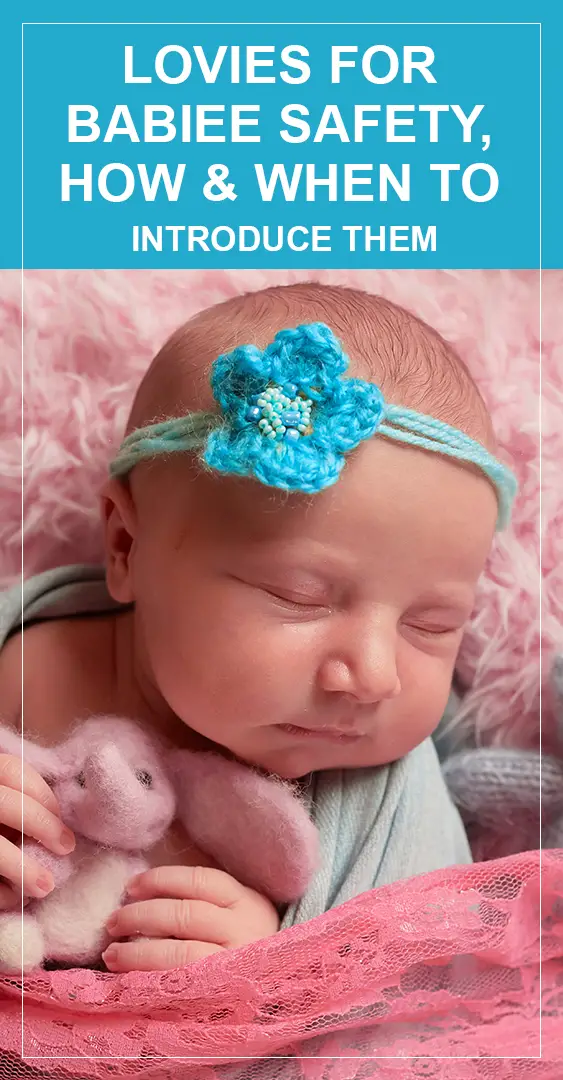
Important: This article is for informational purposes only. Please read our full disclaimer for more details.
A child’s bond to any object for comfort and safety is not unheard of. For instance, in the virtual world, Christopher Robin had Pooh, and Calvin had Hobs the tiger. Such comfort objects or transitional objects are also known as loveys.
Many parents and experts believe that loveys could help soothe a baby and may even help them sleep better. Interestingly, not every baby will have a lovey. So, should you introduce one?
Read this post to know more about loveys, their safety, how to introduce them, and how to choose one.
Lovies For Babies
What Is A Baby Lovey?
Lovey is an object or item to which a baby can bond for comfort and security. It can be any object, such as pillows, toys, blankets, pacifiers, handkerchiefs, or even books. These objects serve many purposes, from helping a baby adjust to a new place to giving them a sense of security. Loveys could be especially helpful when babies are learning to sleep on their own.
When To Start Using A Baby Lovey?
A baby can be offered any type of lovey while they are awake right from birth. However, you must not allow a baby to sleep with a lovey until they are at least 12 months old. According to the American Academy of Pediatrics, toys, pillows, blankets, and any other object placed on the baby’s sleep area could increase the risk of suffocation (1). It may ultimately increase the risk of sudden infant death syndrome (SIDS).
You may offer smaller loveys, such as stuffed toys, during sleep once the baby is older than 12 months. It is the age when most baby sleep-related restrictions are usually relaxed. For instance, a baby need not be placed on their back from the age of 12 months (2).
You may wait until the baby is 24 months old before introducing larger loveys, such as baby pillows or blankets, during sleep (3). Larger loveys could easily slide over the baby’s face and make them susceptible to suffocation. Two years is the age when most babies attain substantial physical abilities, including the ability to move or throw objects (4). Thus, a two-year-old is more likely to be able to push away a lovey that accidentally slides over their face during sleep.
Are Loveys Safe For Babies?
Most loveys are safe for babies of all ages if they use them while awake. Parents must also use the loveys carefully and as per instructions for maximum safety. You can ensure safety by keeping a few precautions in mind while choosing a lovey.
How To Choose A Lovey?
Keep the following safety precautions in mind while choosing and using a lovey.
- Prefer small and soft loveys, such as soft toys, for babies younger than six months. A baby is unlikely to be injured if the lovey falls on them.
- Choose a stuffed toy without any small bows, buttons, detachable items, or dangly decorative items. These trinkets may snap out from the toy and increase the risk of ingestion and accidental suffocation.
- Once the baby is 12 months old, offer small loveys, such as small stuffed animals or soft books, during sleep. Avoid pillows and blankets.
- Do not pick anything with long ribbons or beaded loops since these might get entangled around the baby.
- You may choose a soft toy that is small enough to be gripped easily in the baby’s hands. You may also prefer toys that are safe for a baby to put in their mouth since young babies tend to pick objects and put them in their mouths (5).
- Babies younger than 12 months could also be offered a pacifier. The sucking action could calm and soothe some babies. Make sure you use a pacifier only after the baby is older than four weeks, which is the age by which breastfeeding or bottle-feeding is established (6).
- It is best to supervise babies younger than six months when they use loveys for added safety.
- Do not offer any loveys during sleep until the baby is 12 months old.
- Babies older than 24 months can be offered any lovey, including pillows, blankets, and books, during their sleep.
- If the lovey is a blanket, keep its corners tightly tucked under the mattress.
- If you are unsure about a particular lovey’s safety, take a pediatrician’s opinion.
How To Introduce A Lovey?
A smell of their mother’s body could give a sense of security to babies. Therefore, when introducing a lovey, the mother may keep the lovey close to herself for some time to introduce the familiar smell to the lovey.
You may try the following steps to ensure your baby adopts a lovey and grows fond of it.
- Introduce a lovey when your baby is playful and in a good mood. This is the time when they are most likely to be receptive to new things.
- Try multiple loveys and see what attracts the most attention from your little one.
- Babies older than 12 months can be offered a lovey to calm down before sleep. You can associate lovey with a soothing bedtime routine and sleep. Thus, each time you show a specific lovey to the child, they know it is time to relax and go to bed.
- Give a lovey to the baby the moment they become cranky or upset. When offering the lovey, prompt the baby to look at it and say how the lovey is there to comfort them and give them company.
- For babies older than 24 months, keep a “calming” blanket that you can use when the baby becomes cranky, upset, or scared. It could help the child calm down the moment they see the blanket.
What Are The Uses Of A Baby Lovey?
The use of a lovey could vary as per the age of the child.
- Birth to six months: Infants during this phase may cry if playing stops (7). You may use a lovey to keep them calm and occupied if you or a caregiver is unable to play with the baby. A pacifier lovey could soothe and calm the baby during bedtime since it is safe to let babies sleep with a pacifier in their mouths.
- Six months to 12 months: This is the phase when separation anxiety begins (8). You may use a lovey to provide a sense of security when you are not around. If the baby shows separation anxiety during bedtime, you may place a lovey within the baby’s line of sight at a distance from the crib. Reinforcing the “protection” offered by a lovey could help the baby feel calm while the lovey is around.
- 12 months to 24 months: By the age of 12 months, babies tend to have a favorite toy or object (9). If you introduced a lovey early, the chances are that the baby already has a favorite lovey. If not, you may introduce a cuddly soft toy and reinforce its use as a lovey to make your little one attached to it. During this phase, a lovey can be used as a snuggle buddy or a companion. Separation anxiety tends to peak during this phase, and a lovey can come across as very helpful.
- 24 months and older: A lovey can be used to calm the child before bedtime. Using a blanket as a lovey can help the baby associate it with sleep and bedtime. A blanket or pillow lovey can also be carried during car rides or air travel, when babies often display boredom and crankiness. You may use a lovey during such situations to distract the baby and calm them down.
Loveys or comfort objects are anything that offers comfort and a feeling of safety. Parents often introduce a lovey to help a child sleep well through the night, overcome separation anxiety, during sick days, and more. Whether it is a blanket, soft toy, or a book, a lovey should be picked after checking its safety and introduced as per the baby’s age.
You Might Also Like:
- Baby Elimination Communication: How To Do It And Benefits
- How to Swaddle a Baby: How To Do It And Benefits
- Baby Wearing: Benefits, Safety Tips, and How To
- Baby Led Weaning: Benefits, How And When To Start It
- 7 Importance of Skin-to-Skin Contact With Baby After Delivery
- Tummy Time For Babies: When To Start And Benefits
- How To Make An Oatmeal Bath For Babies?
- Should You Let Your Baby Cry It Out To Sleep?
Image Credit: freepik

















